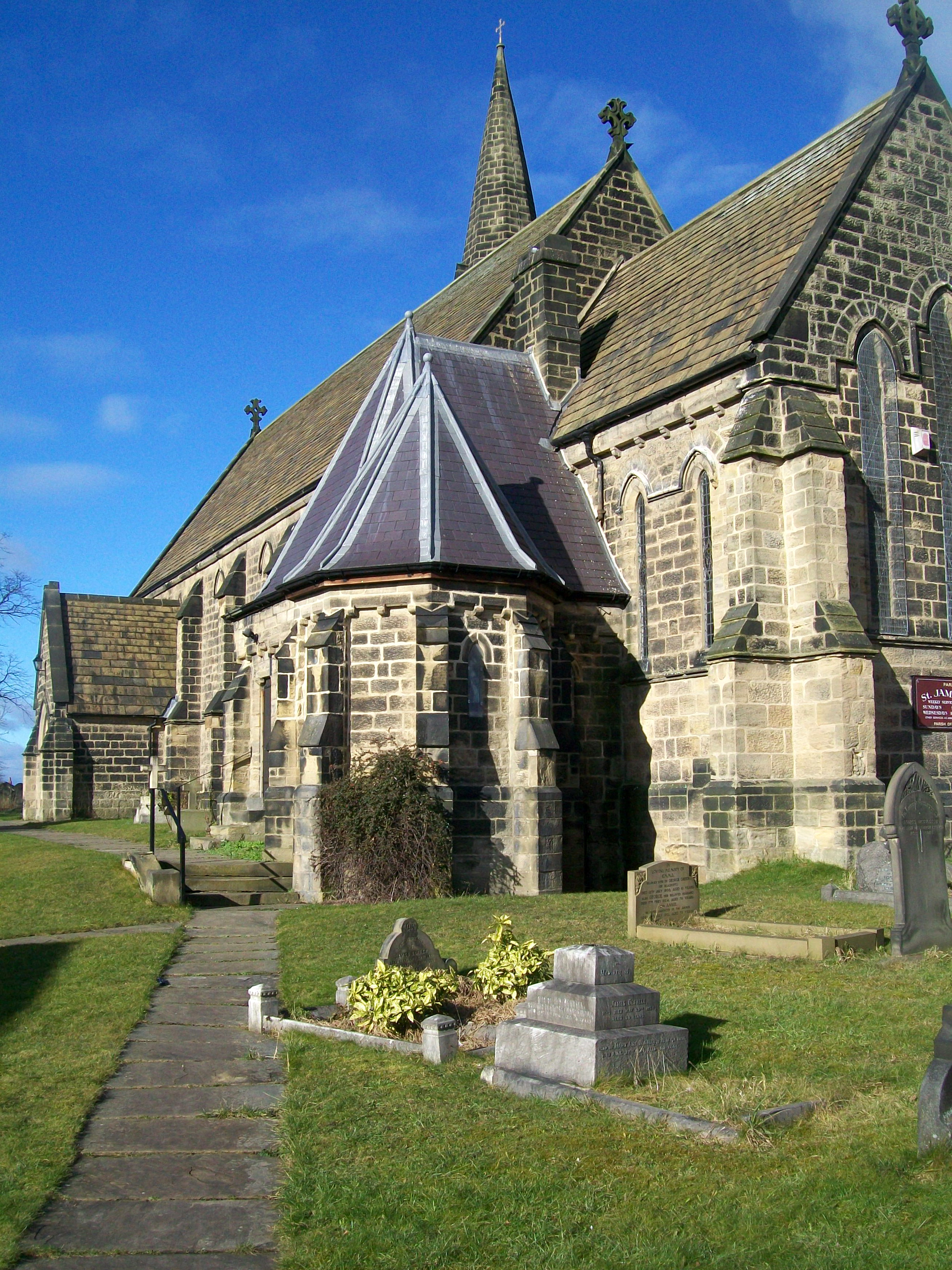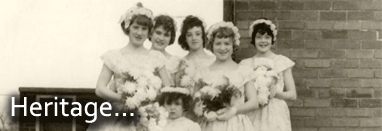History of St James’ Church
The ecclesiastical parish of Seacroft was created in the 1840’s. Until that time Seacroft formed part of the parish of Whitkirk.
It was John Wilson of Seacroft Hall and the Revd Arthur Martineau, Vicar of Whitkirk, who promoted the plan to build a church at Seacroft and they were major contributors to the cost of creating the building. The other sources of funding were the Diocesan Building Society and Trinity College Cambridge. Land was granted by Stephen Nicholson of Roundhay, Seacroft then being part of this manor. The foundation stone of the new St James’ Church was laid by John Wilson JP on 22nd July 1844. The architect for the church building was Thomas Hellyer of Ryde on the Isle of Wight.

The church was consecrated by Dr. C.T. Longley, Bishop of Ripon, on 28th November 1845 and it aquired its own Chapelry District the following year. St James’ was built of Roundhay Stone at a cost of £3174.
It was built by Benjamin Russell of Leeds. The spire is 94 feet high and the clock was original in 1845. Three bells were donated in 1865 by Martha Wilson, who died in 1869. They were given in thanksgiving for her 90th birthday. In 1984, the bells were taken down and recast by John Taylor and Co. of Loughborough to provide the present lightweight ring of five.
The Chapelry District of Seacroft became a new parish in 1856 under Lord Blandsford Act, and Order in Council dated 30th September 1873 ratified an exchange of parochial territory betweem the new parishes of Seacroft and Manston.
The church also contains a memorial to Revd John Hepher, Vicar of the parish for 22 years, who died on 28th April 1898 aged 70. The original stone font was replaced in 1878 by the present font which was moved to its existing position when the Saint James’ Community Room was opened. It is made from Alabaster with small columns made from Derbyshire Blue John. It was paid for by John Wilson in memory of his daughter Ann. The lid commemorated the Revd Cyril Arthur Maurice Adams who was vicar of St James’ from 1952 to his death on 26th August 1964 at the age of 46. A memorial marks his grave which is adjacent to the pathway by the vestry door. Prior to becoming Vicar of Seacroft, Cyril Adams had been Vice-Principal of Chichester Theological College.
There are many memorials in the churchyard, including Agnes Stewart, Mother Superior of St Saviour’s Home at Knostrop who died on 30th April 1886. Sister Agnes had asked to be buried at St Hilda’s Cross Green, but, by the time of her death, the churchyard there was closed and so her mortal remains were brought to the nearest Parish, which at that time was Seacroft. The granite obelisk is the tomb of Alderman Edmund Stead of New Manston Hall, now Seacroft Hospital. Richard Stead, the alderman’s grandson (died 1826) is also remembered with his wife Christine and daughter Joyce (died 1956)
Other tombstones include Jonathan Phillips of Foundry Mills, Joseph Burton killed at the Garforth Sisters Pit in 1900 at the age of 55, and the Sowden family of the old “Lion and Lamb” inn. Other graves include those of James Fowler (1830 – 1899), Head Gardener to the Earl of Harewood for 35 year; and Isaac Chippindale (1826 – 1889) of Scholes brickworks together with his wife Charlotte (died 1865 aged 39) and four of their children who all died in infancy. The churchyard extension in Saint James’ Approach is now maintained by Leeds City Council.
Inside the church building, there are two oak plaques to John Wilson (1808 – 1891) and his son Darcy Bruce Wilson. A brass plate on the north wall indicates that the east window was installed in June 1868 and placed in memory of Sarah Wilson, daughter of John and Matha. The reredos, too, commemorates Sarah Wilson and also dates from 1868. It is carved from Caen Stone and, except in Lent, it is nowadays normally covered by curtaining which is changed to reflect the different colours of the liturgical year.
The Wilson family vault lies beneath the church and contains the mortal remains of Isabella Wilson (died 1867 aged 5) Roderic (1847 – 1881), Louisa (1862 – 1948) as well as John, Martha and Darcy Bruce Wilson.
There is a board in the church stating that the building was erected in 1845 and that it contains 400 sittings, of which 323 are said to be free for ever by reason of a grant from what is now the Leeds Church Extension Society. The board bears the names of the first Vicar of St James’, the Revd. R.H. Blanshard, and the churchwardens W.S. Townend and John Hirst.
The tile dado in the Sanctuary area features a trailing vine and pelicans, and commemorates Mary Wilson, wife of Major General Bush, who died at Bath on 25th May 1883. The inscription is now in what has become the choir vestry.
A harmonium was in use for many years as no organ chamber had been provided. However, it had been generally wished to have an organ for some time and John Wilson contributed £100 to the organ fund and £50 for the organ chamber, subject to the chamber being built on the south side of the chancel rather than the north side as originally suggested. Ominous cracks as a result of old coal workings necessitated strengthening the south side and so a new chamber was added, the foundation stone being laid on 14th March 1873. The organ was built by Isaac Abbott of Leeds and formally opened on Wednesday 10th September 1873 at 4pm by J. Varley Roberts of Halifax. The Sermon was preached by the Revd T.C. Smyth D.D., Vicar of Saint Chad’s, Far Headingley. On 11th September, the Rt Revd Bishop Ryan D.D., Vicar of Bradford preached to a large congregation. The organ was subsequently moved to its present position in the north transept, with choir vestry beneath, possibly when the church was re-ordered in 1955.
The church was again re-ordered in 1970 when the Lady Chapel altar was placed at the Chancel step, the choir stalls were moved from the Chancel to the former Lady Chapel, and the pulpit was removed. The High Altar was subsequently moved forward from the east wall and the Lady Chapel altar moved to the north aisle near the choir vestry doorway.
The St James’ Community Room at the west end of the church was established in the course of a project which involved the building of a kitchen and toilets on the north side of the church, and the adding of the handsome oak screen, false ceiling and new flooring, thus providing a very suitable and comfortable area for meetings, children’s activities, and community use. The Community Room was opened by Mrs Jane Young and dedicated by the Bishop of Ripon, the Rt Revd David Nigel De Lorenz Young on 3rd July 1988.
Today the congregation of St James’ meets every Sunday morning at 10am to worship God, to meet together to pray for and serve our community and the wider world. We are a friendly and inclusive congregation of all ages and welcome new and old friends to come and join us.


